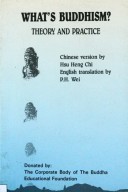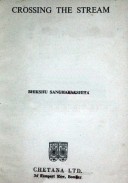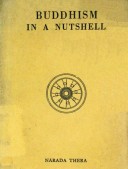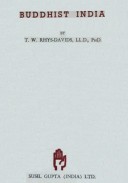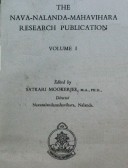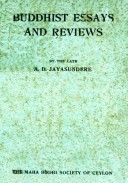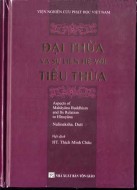Tìm Sách
Sách tiếng Anh-English >> What’s Buddhism Theory & Practice
Thông tin tra cứu
- Tên sách : What’s Buddhism Theory & Practice
- Tác giả : Hsu Heng Chi
- Dịch giả : P.H. Wei
- Ngôn ngữ : Anh
- Số trang : 77
- Nhà xuất bản : Hong Kong Buddhist Books Distributor
- Năm xuất bản : 1973
- Phân loại : Sách tiếng Anh-English
- MCB : 1210000007025
- OPAC :
- Tóm tắt :
MCB: 1210000007025
Pages: 77
CONTENTS
PART ONE – THEORY
Preface……………………………. v
Foreword………………………. vii
Chapter 1. What is the cosmic life?……… 1
- Phenomena of the universe…….. 1
- The stream of Life………………… 2
- Who am I?……………………………. 3
- Delusion, karma and suffering… 4
Chapter 2. Fundamental Turning-point
— Understanding the nature of mind…… 6
- What is self-nature?……………… 6
- Mind………………………………….. 9
- The interrelationship of mind, things and nature.. 12
Chapter 3. The problem of practising Buddhism. 14
- The objective of Buddhism……………………………. 14
- Some fundamental prerequisites……………………… 14
- General rules of mind-cultivation…………………….. 16
- Look into the mind – a fundamental simple method of cultivation 17
- People and affairs are opportunities for mind-cultivation 19
- The Name-reciting Method — another miraculous efficacious method 20
Chapter 4. Some erroneous criticisms of Buddhism refuted 23
- Buddhism is NOT a treatise on “Mind-only”…………….. 23
- Buddhism goes MORE THAN moral preaching………… 24
- Buddhism is NOT negative and pessimistic Escapism… 25
- Buddhism is NOT established on the basis of Theology 26
Conclusion……………………. 28
PART TWO: HOW TO PRACTISE BUDDHISM
Chapter 5. Frustrated and Despairing Buddhists….. 29
Chapter 6. The Importance of Cultivation……………. 31
Chapter 7. The Aim of Cultivation……………………… 33
Chapter 8. The significance of Cultivation…………… 37
Chapter 9. Methods of Cultivation……………………… 40
- General Cultivation………………………….. 40
- Some Fundamental Methods……………… 43
- Ch’an Practice…………………………….. 43
- Looking into the Mind………………….. 46
- Tantric Practice…………………………… 51
- Name-reciting……………………………… 54
- The Common Characteristic of Integration of all Methods of Cultivation 57
Chapter 10. In the Course of Cultivation… 65
- In the Course of Eliminating ‘Habits’….. 65
- Stages of Progressive Development and Order of Postitions… 67
- When may Supreme Enlightenment be Attainable?… 71
Epilogue………………………. 74
Notes & Glossary…………… 75
PREFACE
What is Buddhism? What has Buddhism to do with all of US in everyday life? How should we learn and practise Buddhism to attain Enlightenment? In answering these vital questions, this book shows us where lies the great significance of Buddhism.
The correct way to understand Buddhism, as this book points out at the outset, is to look into every aspect of Buddhism objectively, unbiasedly and thoroughly. Buddhism is everyone’s Dharma. For us, Buddhism lies nowhere but rightfully in the phenomena of the world.
Imparting general knowledge of Buddhism, this book presents a cursory review of the essential aspects of Buddhism in a broad outline. In Part One some fundamental questions such as the interrelationship of matter, mind and nature, the phenomena of the universe and human life, the Law of Causality, the question of suffering, and others are treated in condensed statements extracted from some popular Mahayana sutras and sastras. What is said in Part Two of the numerous and diversified Buddhist practices on mind-cultivation comes from no-other source than those Patriarchs’ and those Enlightened Masters’ own experiences of self-realization.
This book is a realistic approach towards understanding and practising Buddhism. Understanding Buddhism is understanding the mind and the self-nature. It is only by understanding the mind and realizing the self-nature that we shall not be blind to the causes and effects of the phenomena around us and that we may be free from every illusion and delusion, free from every passion and free from every suffering. From the standpoint of practice, cultivating Buddhism is cultivating the mind and cultivating the mind is cultivating awareness. It is only by cultivating awareness that we can be free from concept and subjective thought and then karma-free. Hence, in Buddhism, there is no Dharma without cultivating awareness.
Prompted by his conviction that the Chinese version, written by Hsu Heng Chi, is intended to clarify the popular misconception about Buddhism and to lead US into right understanding of this vital question, the translator undertakes to render it into English, for the interest of English-speaking readers. Being conscious of his incompetance, he assumes full responsibility for every error of mistranslation.
To Rev. Lok To of the Buddhist Association of the U.S., whose kind encouragement and support is a strong incentive to his undertaking the translation in question, the translator wishes to express his most grateful thanks.
Peace to All.
Upasaka p. H. Wei,
May 10, 1973.
FOREWORD
Touching on the question of Buddhism, my friends generally opine that Buddhism, based on Theology, is unscientific and superstitious, and apart from its moral teaching, there is not much of it; some of them say that its theory, however profound, is idealistic, impractical and not worth learning; and some others from their year-long study may know something of its profundity and comprehensiveness but without understanding its basic Doctrine, still have not firmly established their faith in it, not to say of putting it into practice or getting any benefit out of it.
Indeed there is much misunderstanding about Buddhism all over the world. However, in view of its world-wide prevalence for over two thousand years, it is evidently clear that its unique special value does not lie in the religious worship, or it would have passed out long ago. Of course, we can never, understand Buddhism correctly if we judge it from what it may appear to us: also it is utterly wrong for US to sort out a Buddhist theory and to infer that Buddhism is totally unpracticable and unrealistic to human life. In other words, in order to arrive- at right understanding of Buddhism, we must guard ourselves against subjective thought and superficial observation and on the other hand, should look into its every aspect objectively, unbiasedly and thoroughly. But if we do not follow this way, then we shall remain ignorant of Buddhism in our lifetime, to live in delusion and in the dark. Therefore, it is a matter of fundamental importance that we should understand Buddhism correctly, and for this purpose, I think, it is advisable as well as highly desirable that Buddhism should be made intelligible to the public if it is presented in a concise and colloquial manner: above all, we should clearly understand that far from being a superstitious belief, Buddhism is the fundamental Truth of the universe and human life.
 Facebook
Facebook
 Google
Google
 Google+
Google+
